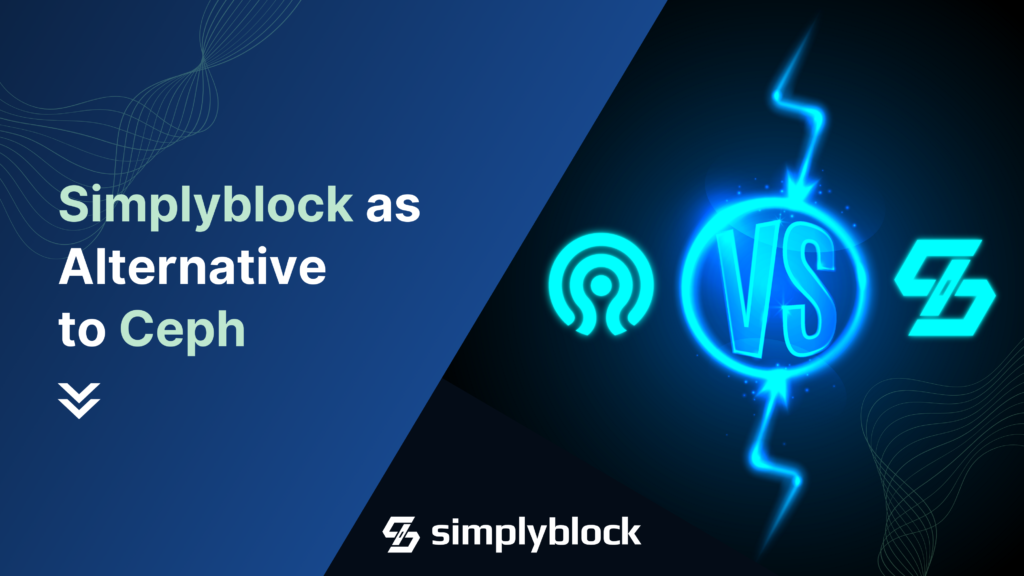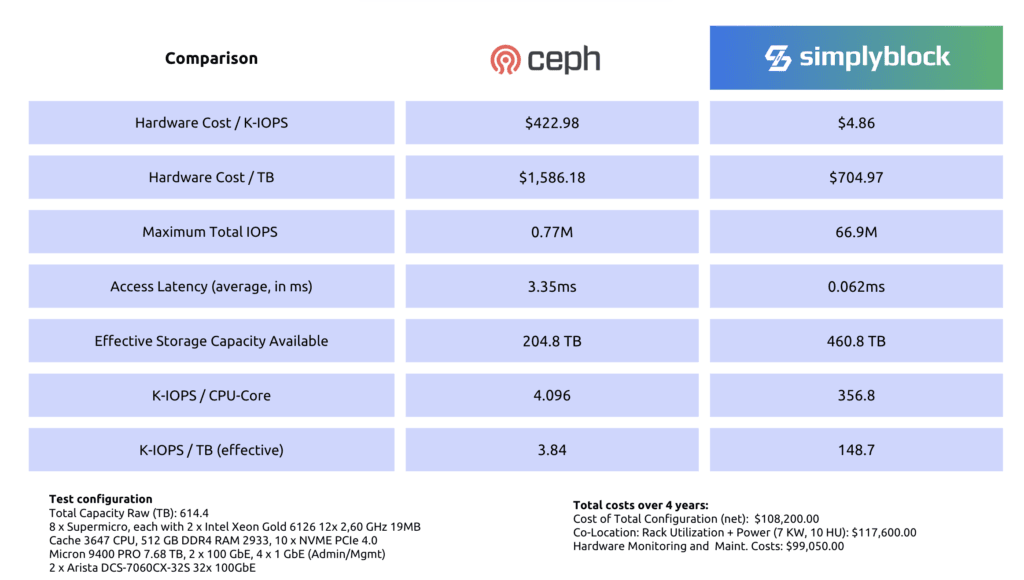
When evaluating software-defined storage, Simplyblock and Ceph stand out as two major contenders. While Ceph has long been a default choice for many cloud and enterprise environments, its architecture struggles to keep pace with modern performance, efficiency, and cost demands. Simplyblock delivers a next-generation alternative designed specifically for high-performance workloads, cloud-native deployments, and cost-efficient scalability.
Ceph: Unified and Feature-Rich Storage
Ceph is a highly scalable, software-defined storage solution that provides unified block, file, and object storage interfaces. It is widely used in private cloud environments, especially in combination with OpenStack, where it has gained popularity as the go-to storage solution.
Ceph utilizes its own storage driver (rbd) that is integrated into the Linux Kernel and can also be used on other platforms as a third-party driver. It enables seamless connectivity between hosts and the Ceph cluster. In addition to OpenStack, Ceph offers deep integrations with Kubernetes through a separate CSI driver, as well as other platforms.
One of the notable strengths of Ceph is its compatibility with various storage types and interfaces, including HDD, SSD, SATA, SAS, and NVMe. It can run on standard x86 server hardware, allowing for flexibility in combining different models, capacities, and vendors to meet specific storage needs.
At the core of Ceph lies the CRUSH algorithm, which is a powerful and decentralized data placement mechanism. This algorithm ensures efficient and flexible distribution of data across the cluster, contributing to Ceph’s scalability and fault tolerance capabilities.
Simplyblock: The Next Generation of Software-Defined Storage
Simplyblock is a next-generation, high-performance software-defined storage platform optimized for NVMe and NVMe-oF. It delivers ultra-low latency, high throughput, and seamless scalability while running efficiently on commodity hardware or cloud instances. Simplyblock is built on NVMe-oF and NVMe/TCP end-to-end, which means that both client-server and backend communication is high-performance.
Simplyblock is purpose-built for cloud-native and hybrid environments, seamlessly integrating with AWS EC2, EKS, OpenStack, OpenNebula, Proxmox, and Kubernetes (via CSI). Its cloud-optimized architecture ensures flexible, scalable deployment across on-prem, hybrid, and multi-cloud infrastructures. Our technology delivers industry-leading resource efficiency, achieving high IOPS per CPU core, optimized raw-to-effective storage utilization, and minimal CPU overhead for compression and deduplication. Our architecture ensures ultra-low latency and seamless scalability, supporting both hyper-converged and disaggregated deployments for maximum flexibility.
Commonalities between Simplyblock and Ceph
Both Simplyblock and Ceph provide unified storage clusters with integration support for OpenStack and Kubernetes. They offer essential data services like snapshots, disaster recovery, compression, encryption, and deduplication. Both solutions support multi-tenancy, can be managed via CLI and APIs, and operate on standard TCP/IP infrastructure without requiring FC or RDMA networking.
Both systems employ a distributed storage architecture for scalability and resilience, using policy-based data placement and failure domains to eliminate single points of failure. This ensures seamless scalability, automatic load balancing, and self-healing in case of hardware failures. However, Simplyblock streamlines management with automated cloud-native deployment, while Ceph requires more manual tuning and setup via Ansible playbooks or other automation tools.
Deployment Comparison
Simplyblock is purpose-built for cloud-native environments and offers seamless integration with Kubernetes, OpenStack, AWS, and on-premises setups. It supports hyper-converged, disaggregated, and hybrid models, allowing organizations to balance compute and storage based on their specific needs.
Ceph, in contrast, requires a dedicated cluster with rigid separation between compute and storage, leading to suboptimal resource utilization and higher costs.
Architectural Differences
Simplyblock: Modern, Efficient, and Scalable
- Built on NVMe & NVMe-oF for ultra-low latency and high throughput.
- Minimalist, container-based storage architecture ensures lightweight deployment and easy management.
- Intelligent data placement via erasure coding for better resilience without excessive overhead.
- Cloud-native and optimized for Kubernetes and hybrid cloud environments.
Ceph: Legacy Complexity and Bottlenecks
- Heavy, multi-layered architecture with high operational complexity.
- Requires extensive tuning to optimize performance on modern NVMe storage.
- Built-in replication leads to significant inefficiencies in storage utilization.
Why Ceph Falls Short
Operational Complexity
Managing Ceph requires dedicated storage teams due to its intricate architecture of OSDs, Monitors, and Metadata Servers. Scaling and upgrading demand careful orchestration, leading to increased administrative overhead.
Legacy Design for Spinning Disks
Ceph was originally designed for HDDs in the pre-cloud era, making it inefficient for NVMe and cloud-native workloads. It suffers from high CPU overhead, suboptimal IOPS, and latency bottlenecks.
Performance Bottlenecks
Ceph’s monolithic design results in access latencies often exceeding 3ms and an average of ~2,000 IOPS per CPU core—far below what modern storage hardware can deliver.
Inefficient Storage Utilization
Ceph’s default triple replication setup leads to a 3:1 raw-to-effective capacity ratio. While erasure coding is an option, it significantly increases access latency and CPU load.
Performance Comparison
The numbers speak for themselves—Simplyblock outperforms Ceph across all key performance metrics. In this example for a given hardware configuration, with 66.9M maximum IOPS compared to Ceph’s 0.77M, Simplyblock delivers exponentially higher throughput. Its 0.062ms average latency is orders of magnitude lower than Ceph’s 3.35ms, ensuring ultra-fast response times for demanding workloads.

Furthermore, Simplyblock achieves a remarkable 356.8 K-IOPS per CPU core, while Ceph lags behind at just 4.096 K-IOPS per CPU core. This superior efficiency translates to significantly lower hardware costs per IOPS and per TB, making Simplyblock the clear choice for modern, high-performance storage infrastructures.
Head-to-Head Comparison
Simplyblock consistently outperforms Ceph across key storage metrics. With superior performance density, lower latency, and better storage efficiency, it provides higher IOPS per CPU core, significantly reducing hardware costs. The ability to operate in hyper-converged, disaggregated, or hybrid models makes Simplyblock far more adaptable than Ceph’s rigid deployment model. Furthermore, Simplyblock’s built-in automation and streamlined management reduce operational complexity, allowing organizations to optimize resources and lower total cost of ownership (TCO) by up to 75% compared to Ceph.
| Feature | Simplyblock ✅ | Ceph ❌ | Why It Matters |
|---|---|---|---|
| Performance Density | ✅ High IOPS per CPU core (~250,000) | ❌ Limited to ~2,000 IOPS/core | Supports NVMe at full potential |
| Latency | ✅ Sub-100μs | ❌ 3ms+ | Critical for databases, AI/ML, and financial workloads |
| Storage Efficiency | ✅ 1:2.5 (with deduplication & compression) | ❌ 3:1 (default replication) | Saves infrastructure costs |
| Deployment Models | ✅ Hyper-converged, disaggregated, hybrid | ❌ Dedicated storage cluster required | Flexibility for different infrastructures |
| Cloud-Native Integration | ✅ Built for Kubernetes, OpenStack, AWS | ❌ Requires custom tuning | Ready for modern workloads |
| Erasure Coding | ✅ Efficiently implemented | ❌ High latency & CPU overhead | High availability without waste |
| Ease of Management | ✅ Simple, automated deployment | ❌ Requires storage experts | Lower operational overhead |
| Cost Efficiency | ✅ Up to 75% lower TCO | ❌ High raw storage requirements | Maximizes cost savings |
Conclusion
Ceph was groundbreaking in its time, but it struggles to keep up with the demands of modern storage infrastructure. Simplyblock offers a streamlined, high-performance alternative that eliminates complexity, maximizes efficiency, and significantly reduces costs. For organizations looking to optimize cloud-native storage while maintaining high performance and resilience, Simplyblock is the clear choice over Ceph.
Read more about simplyblock storage as alternative to Ceph storage.
Questions and Answers
Simplyblock is a modern, cloud-native software-defined storage solution optimized for NVMe over Fabrics, while Ceph is a legacy distributed storage platform built for flexibility but with high complexity and lower overall performance. Simplyblock prioritizes ease of use, performance, and Kubernetes-native integration.
Yes. simplyblock leverages NVMe over TCP for low-latency, high-throughput volumes, delivering significantly better IOPS and latency compared to Ceph, which often suffers from performance overhead due to its architectural complexity.
Simplyblock is purpose-built for cloud-native and containerized environments. It offers seamless CSI integration, dynamic provisioning, and encryption at rest, making it ideal for Kubernetes, VMs, and hybrid workloads without Ceph’s operational burden.
Ceph is still widely used for legacy and mixed workloads, but many teams are shifting to lightweight, high-performance alternatives like simplyblock. For environments prioritizing speed, scalability, and simplicity, Ceph’s complexity is often a drawback.
Yes, migration from Ceph to simplyblock is straightforward using replication and volume provisioning. Simplyblock supports hybrid environments and allows gradual cutover, enabling storage modernization without downtime.
